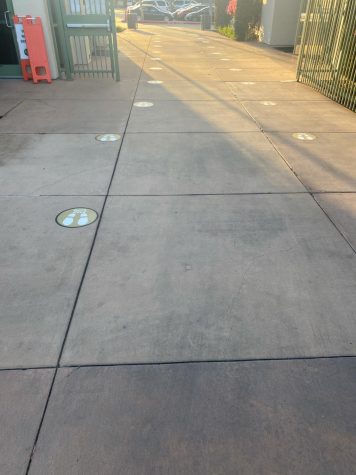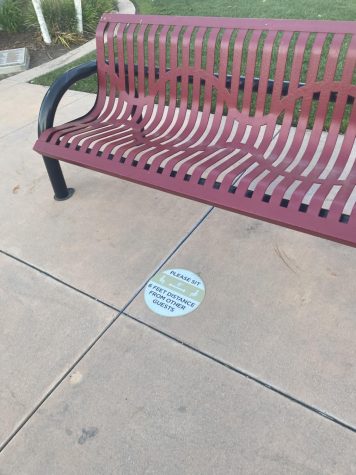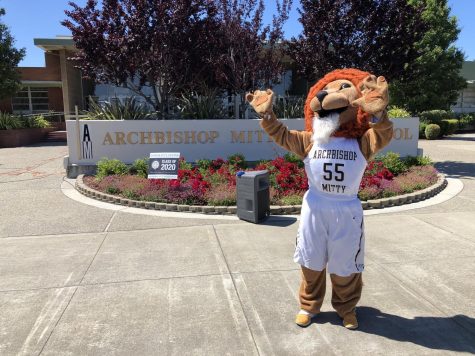Welcome Back Monarchs: A Look Into Hybrid Learning
It’s almost been a year since Mitty has last seen bustling hallways and casual conversations on campus. Yet, despite the silence that has long prevailed, individuals behind the scenes have been working busily over the past few months in preparation for the coming reopening of the school’s campus. The plans for a slow return to campus have led to many challenges and adjustments, but also anticipation as students and faculty readied themselves for a return to campus on March 8. Here is a look at the current state of Mitty's hybrid learning.
March 15, 2021
On School Traffic
A typical day of a Mitty student on campus begins with the usual check-in process. First, students complete an initial temperature screening at home to ensure that they are in good health condition, and they obtain a QR code upon completion. Then, entering one of three main access points (senior parking lot, east parking lot, or the front entrance of the school), they use this QR code to go on-campus. Depending on the day, only specific colors of the QR code provide students with successful access to the school. This is to ensure that only a select number of students enter campus on any given day. Half of the students who decided to do hybrid learning are brought to campus every Monday and Tuesday and the other half every Thursday and Friday. If, in any case, a student is unable to complete the check-in process, they are asked to head over to the main entrance–the problem-solving site for such unanticipated issues.
Once students are on campus, they then follow a number of directional signs along the walls, coordinated in a one-way street fashion to reduce unnecessary student interaction. As part of this plan, students who arrive on campus earlier than expected can branch out to other sections of campus like the library or cafeteria, maintaining social distancing while engaging with other students. The library is open by 7:00 a.m. every morning, and designated spots are also reserved for students to sit down and spend time within the school. Regarding school traffic, in particular, Mr. Mathews, Associate Principal, notes the importance of following “traffic patterns” when heading to assigned classrooms, stating that while “there will only be 35% to 40% of students here each day, you can still wind up in crowds, and we want to avoid that as much as we can. We truly want to avoid clustering.”

When students finally enter their respective classrooms, the setting may feel a bit unfamiliar. Half the desks are labeled with green stickers, indicating they are reserved for use only during odd-numbered periods; conversely, those without a sticker indicate use only during even-numbered periods. The reason for this, as Mr. Mathews elaborates, “is so every day every desk only gets used twice because there are four classes in the classroom, and there’s always going to be a period in between uses.”
Between classes, students can expect personnel to come in and spray the desks, leaving the desks wet with the spray as recommended by health professionals. In regards to safety protocol, Mr. Mathews stresses the importance of staying six feet apart from other students and teachers, even if the desks are oriented opposite of one another. To put it bluntly, he states, “while there may well be some people who test positive this year and we want to make sure that we take care of them, let’s not make a bunch of other students go home because you were in close contact with other students or your teachers.”
On In-Classroom Teaching
In an effort to coordinate in-classroom and distance learning, the school has made several innovative adjustments to the classroom. For starters, every classroom has a cart at the front of the room, from which teachers can broadcast the physical board to Zoom via the cameras attached to the carts. If desired, teachers can also project their computer screens to both the big screen and zoom screen sharing, allowing students both at school and at home to engage more effectively with one another. Classroom speakers and mics are also provided to ensure comments shared in the classroom can be heard online and vice-versa. Not all teachers are required to use their provided technology in this way. Some teachers, such as science teachers, can heavily rely on screen-sharing to project lab demonstrations since labs both in and out of the classroom are difficult to complete given the current COVID-19 guidelines.
Under circumstances in which a teacher is not available for in-person learning, the plan for hybrid learning will still be upheld. Students who have signed up for in-classroom learning are expected to attend classes at Mitty and continue their on-campus experience. While the teacher is not present, a supervising adult will be there to facilitate the class, respond to concerns, and direct students to log in to their “virtual classroom pages” to access learning material. Mr. Mathews recognizes that such occurrences are “not optimal but are going to happen” given the unpredictability that the COVID-19 pandemic has brought.
The challenge behind this hybrid learning model, however, is not primarily technological burdens or class adjustments. The real obstacle, as Mr. Mathews describes, is this: “I challenge all the students to guard against the natural tendency to suppose that if I put a mask on my face, I’m supposed to be quiet. I want my students to get over that. Come on, speak loudly so I can hear you. I’ll speak loudly so you can hear me. I can’t see your full face. I need to know that you have a raised smile and with a mask I can’t do that. If you’re responding, then there’s still going to be energy. I ask for your participation. I’m urging all students to work against the supposition that the masks can make you withdraw within yourself and not participate in class.”
On Out-of-Classroom Opportunities
But what about periods of time during the school day that fell outside the academic sphere, such as lunch and free periods? In order to create a sense of normalcy, lunch sessions have readjusted to the typical A and B schedules that were in place prior to COVID-19. This reduces the number of students eating lunch together at any given time. In order to steer away from confusion regarding health protocols and to provide direction, signs placed on the picnic tables serve as indicators for how many people can be seated per table and which locations are available for seating. For those who wish to eat lunch from school instead of bringing their own from home, there is the option of preordering a boxed lunch that they can subsequently pick up at school in order to effectively reduce the risks that accompany lengthy lunch lines.

To ensure free periods are still stretches of time for students to relax, socialize, or get a head start on completing class assignments, popular centers of congregation such as Aymar and the Sobrato Center are open for students to, according to Mr. Mathews, “sit apart from one another and chat and get some work done.” To facilitate this, some chairs and tables have been removed or marked as off-limits and supervisors are there to help remind students to be socially distanced, allowing students to freely enjoy their off period while adhering to health requirements. Centers such as the Campus Ministry Office are also accessible, with some furniture being removed to create a spacious environment. Several other notable Mitty offices, such as the Outreach Office and the newly added DEI Office are open as well, providing opportunities for students to interact with faculty. However, the math and science labs remain closed, so students have to stick to scheduling time with teachers during Wednesday office hours.
When students arrive at school for afterschool activities, they are to comply with the same check-in process and screening procedures as the students did during the regular day. As a flurry of students leaves after the school day and new ones take their place for co-curricular activities, the latter proceeds with their check-in to confirm the activities they are doing for the day before setting foot on campus. The intent of this organized regimen is to seamlessly transition from school to the activities that follow in a fashion that minimizes as many health risks as possible.
On Community Building
Community building, of course, isn’t the same as before, so maneuvering around this challenge has proven to be a hurdle. In regards to future plans, retreats have been fully planned. As Mr. Mathews elaborates, “They will not be overnight retreats. They will be done on campus, but Quest and Kairos are still in place, and those will be held.” Students who signed up for these retreats will arrive at Mitty during their designated time to engage in socially distanced student bonding activities, but not before undergoing the standard check-ins and health screenings. A creative form of the Mitty staple, Monarch Madness, will be held as a virtual experience, with spectators viewing from a drive-in theater or their homes.
Should a student test positive, they are to immediately notify the Dean’s Office, where they will share any individuals–students and teachers–they have been in close contact with. This step is to ensure that further spreading of the virus can be mitigated as quickly as possible. Ms. Monson, Dean of Students, is the lead coordinator of such circumstances and will send out a report to Santa Clara County detailing confirmed COVID-19 cases on campus to ensure an accurate count is maintained. She is also responsible for reaching out to any Mitty students or faculty who have possibly been exposed to the virus, mandating a minimum two-week quarantine in which in-class learning must be temporarily suspended.
The process of COVID-19 testing for faculty, in particular, remains fairly similar to that of the students: they report their positive testing, state any individuals that they have been in close contact with, and stay at home for a minimum of 10 days. The only major difference in the COVID-19 testing process for faculty is that reports are sent not through the Dean’s Office but through the HR office instead. In handling faculty or employee-related issues, the HR department aims to ensure that all adults on campus remain safe and secure during their time at Mitty.
On Challenges
The issue of staffing is a priority as the hybrid model requires teachers to supervise students, complete continuous check-ins, and comprise the support personnel. To gauge the turnout, an assessment was held in which it was reported, “…more than half the teachers (60%-70%) will be here during red.” Creating a personalized workspace for these teachers will be quite the feat, as “teachers obviously can’t sit in their classrooms once they finish teaching the class.” Thus, the focus has also turned towards “opening up areas on campus to spread desks out” while also giving teachers their workspace.
Fewer teachers combined with only having five hundred to six hundred students on campus during the day raises the concern of whether or not the energy that defines the Mitty campus will be preserved. “I think the biggest challenge is to envision how we manage a place that is so active and alive like Mitty during the day,” Mr. Mathews says. This hybrid learning model is sure to provide a unique outlook for students, different from anything experienced before on campus.
But in the face of these challenges, Mr. Mathews advises students to make the most of what they have: “Don’t measure this against what school used to be like. Measure it against distance learning. Because I think hybrid will be way more fun than distance learning, but if you think it’s going to be like the old days…we’ll defeat ourselves before we start.”

